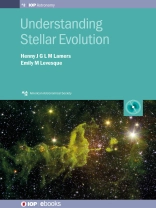Understanding Stellar Evolution is based on a series of graduate-level courses taught at the University of Washington since 2004, and is written for physics and astronomy students and for anyone with a physics background who is interested in stars. It describes the structure and evolution of stars, with emphasis on the basic physical principles and the interplay between the different processes inside stars, such as nuclear reactions, energy transport, chemical mixing, pulsation, mass loss and rotation. Based on these principles, the evolution of low- and high-mass stars is explained from their formation to their death. In addition to homework exercises for each chapter, the text contains a large number of questions that are meant to stimulate the understanding of the physical principles. An extensive set of accompanying lecture slides is available for teachers in both Keynote® and Power Point® formats.
Tabla de materias
1 – Stars: setting the stage
2 – Observations of stellar parameters
3 – Hydrostatic equilibrium and its consequences
4 – Gas physics of stars
5 – Opacities in stars
6 – Radiative energy transfer
7 – Convective energy transport
8 – Nuclear fusion
9 – Stellar timescales
10 – Calculating stellar evolution
11 – Polytropic stars
12 – Star formation
13 – H fusion in the core: the main sequence phase
14 – Principles of post main sequence evolution
15 – Stellar winds and mass loss
16 – Shell H fusion in low mass stars: the red giant phase
17 – Helium fusion in low mass stars: horizontal branch stars
18 – Double shell fusion: Asymptotic Giant Brach stars
19 – Post-AGB evolution and planetary nebulae
20 – White dwarfs and neutron stars
21 – Pulsating stars
22 – Observations of massive stars: evidence for evolution with mass loss
23 – Evolution of massive stars of 8 – 25 Mʘ
24 – The evolution of massive stars of 25 – 120 Mʘ : dominated by mass loss
25 – Rotation and stellar evolution
26 – Late evolution stages of massive stars
27 – Supernovae
28 – Principles of close binary evolution
29 – Close binaries: examples of evolution with mass transfer
30 – Chemical yields: products of stellar evolution
Appendix A – Physical and astronomical constants
Appendix B – Stellar parameters
Appendix C – Solar Model
Appendix D – Main sequence from ZAMS to TAMS
Appendix E – Acronyms
Sobre el autor
Short version
Henny J G L M Lamers is Professor Emeritus in Astrophysics at Utrecht University and the University of Amsterdam. He is a member of the Netherlands Royal Academy of Arts and Sciences, and an Honorary member of the American Astronomical Society. Emily Levesque is an Assistant Professor of Astronomy at the University of Washington in Seattle. Her research accolades include a 2017 Alfred P Sloan fellowship in physics and 2014 Annie Jump Cannon research prize from the American Astronomical Society.
Long version
Henny J G L M Lamers is Professor Emeritus in Astrophysics at Utrecht University and the University of Amsterdam. He is a member of the Netherlands Royal Academy of Arts and Sciences, an Honorary member of the American Astronomical Society, Honorary Brittingham Chair at the University of Wisconsin (1989), Nominee Teacher of the Year of the Utrecht University, and received the Schmeits Award for Astronomy in the Netherlands (1980). He is author/editor of nine professional astronomy books and author of four popular astronomy books.
Emily Levesque is an Assistant Professor of Astronomy at the University of Washington in Seattle. Her research accolades include a 2017 Alfred P Sloan fellowship in physics and 2014 Annie Jump Cannon research prize from the American Astronomical Society. She was both an Einstein and Hubble postdoctoral fellow at the University of Colorado, and received her Ph D in astronomy from the University of Hawaii and her SB in physics from the Massachusetts Institute of Technology.












